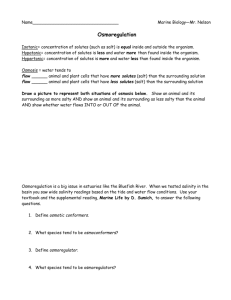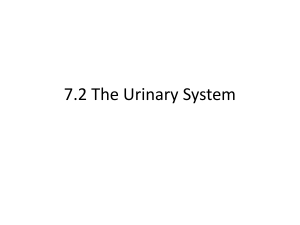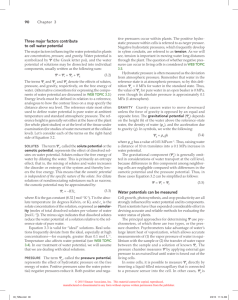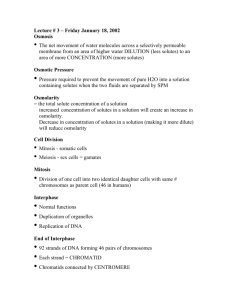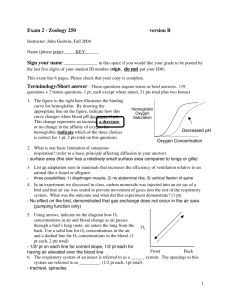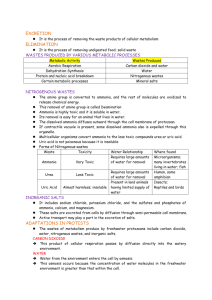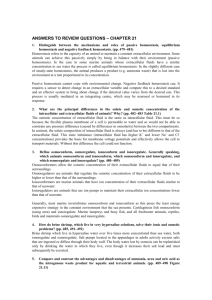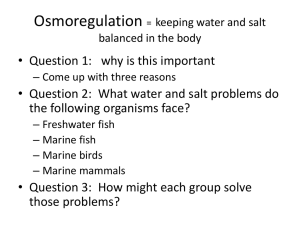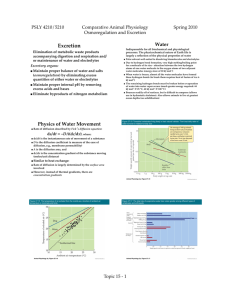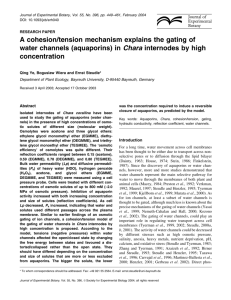Osmoregulation
advertisement
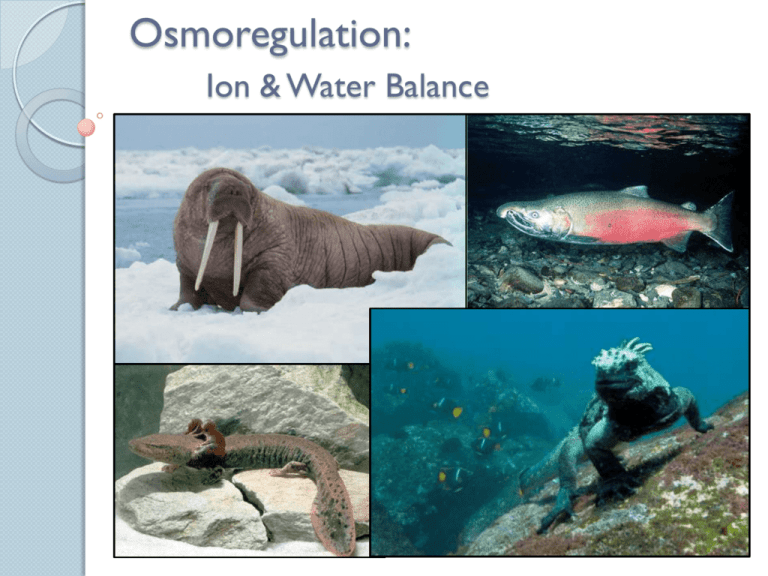
Osmoregulation: Ion & Water Balance Osmoregulatory Challenges Osmotic Regulation ◦ Control of tissue osmotic pressure Ionic Regulation ◦ Control osmotic composition of body fluids. Nitrogen Excretion ◦ Pathway by which animals excrete ammonia Consequences Changes in the concentration of ions have the potential to affect the structure and function of macromolecules. Cells exposed to osmotic gradients can shrink or swell. Changes in cell volume can damage cells directly. Regulating Internal Environment Marine environments: ◦ High level of ions, mostly Na+ and Cl◦ Must expel ions against electrochemical gradients ◦ Obtain water against osmotic gradients Regulating Internal Environment Freshwater environments: ◦ Low levels of ions ◦ Acquire ions against electrochemical gradients ◦ Dispose excess water against osmotic gradients Regulating Internal Environment Terrestrial environments: ◦ Live under dehydrating conditions ◦ Water loss is the greatest threat ◦ Must obtain ions from diet Regulating Internal Environment Animals that straddle multiple environments must have flexible homeostatic mechanisms to cope with variable ion and water levels. Aquatic Animals Ionoregulatory and osmoregulatory strategies of aquatic animals can be distinguished by: ◦ The differences between exracellular fluids and external conditions ◦ The extent to which extracellular fluids change when external conditions change Aquatic Animals Conformers: have internal conditions similar to the external conditions, even when external conditions change. Regulators: defend a nearly constant internal state that is distinct from external conditions Ionic Regulation Ionoconformer: ◦ exerts little control over the solute profile within its extracellular space. Ionoregulators: ◦ control levels of most ions in extracellular fluids ◦ employing a combination of ion absorption and excretion. Osmotic Regulation Osmoconformer: ◦ internal osmolarity nears that of the external environment ◦ if external conditions change, internal osmolarity changes with it. Osmoregulators: ◦ Maintains internal osmolarity within an narrow range regardless of the external environment. ◦ Depending on conditions, the animal could have an osmolarity higher or lower than surrounding water. Osmotic Tolerance Stenohaline = animals that can only tolerate a narrow range of salt concentrations Euryhaline = animals that can tolerate widely variant osmolarities No predetermined relationship between strategy and degree of tolerance. Osmotic Tolerance Necessity of Water All animals require some source of water Dietary Water Diet is a mixture of water and solutes in various chemical forms. Aquatic animals: ingest some liquid water while eating, and must manage the resulting osmotic and ionic consequences. Plant and animal tissues are an important source of dietary water Dietary Water Dietary water: this water is preformed in the food, either trapped within solid food or as a liquid component of meal. Animals cannot consume all of the dietary water because some must be retained to give feces appropriate consistency Dietary Water Once ingested, many macromolecules undergo hydrolysis as part of digestion. ◦ Minor investment of water early in digestion. Later metabolic processes generate water as a result of oxidative phosphorylation = metabolic water. Classification of Solutes Perturbing Solutes: ◦ Can disrupt macromolecular functions at regular concentrations within an animal. Na+ , K+ , Cl- , charged amino acids Compatible Solutes: ◦ Have little effect on macromolecular function ◦ Therefore, can accumulate to high concentrations without deleterious effects Polyols and uncharged amino acids Classification of Solutes Classification of Solutes Counteracting Solutes: deleterious on their own, but can be used in combination where effects of one counteract the other ◦ Urea & methylamines Cell Volume Cells control their volume by transporting solutes across the plasma membrane Animals regulate the composition of exracellular fluid: ◦ external solution allows cells to maintain appropriate cell volume. Role of Epithelial Tissues Epilthelial tissues form the boundary between the animals and the environment Same properties that make it good at gas exchange & nutrient absorption ( surface area & permeability) make it more vulnerable to ion and water movements. Integument is an Osmotic Barrier Animals reduce the flux of water across the body surface by limiting the water permeability of the epithelial tissues ◦ To reduce permeability: some animals reduce aquaporin proteins ◦ To reduce water loss: some animals cover external surfaces with a thick layer of hydrophobic molecules. Terrestrial Vertebrate Skin Diversity in terrestrial vertebrate skin due to construction of the stratum corneum Terrestrial Vertebrate Skin Scales of reptiles and birds composed of interconnected patches of stratum corneum. ◦ Largely keritin Mammalian skin is also keritinized ◦ Modifications of the keretinized stratum corneum allow for different structures. Terrestrial Vertebrate Skin Specialized Properties Specialized Properties 1. Asymmetrical proteins distribution of membrane 2. Tight intercellular connections govern paracellular movement 3. Multiplicity of cell types 4. High density of mitochondria Movement of Solutes Solutes move across epithelial tissues by paracellular and transcellular transport. Transcellular transport: movement of solutes (or water) through epithelial cells Paracellular transport: movement of solutes (or water) between adjacent cells. Movement of Solutes Leaky epithelia: ◦ tissues that permit paracellular transport Tight epithelia: ◦ tissues that conduct minimal paracellular transport. Transporters include: ◦ ◦ ◦ ◦ ATPases (ex. Na/K+ ATPase) Ion channels (ex. Cl-, K+, and Na+) Cotransporters Exchangers Freshwater v. Saltwater Freshwater has low [solute], creating inward osmotic pressure, and driving uptake of water Animals that drink seawater face 2 challenges: ◦ Water molecules must be selectively transported across the gut against the osmotic gradient. ◦ Must be able to expel the salt that accompanies the seawater consumed in diet. Fish Gills Mucus secreting cells along surface of gill Chloride cells (PNA+) ◦ large cells with abundant mitochondria Pavement cells – smaller, flattened cells ◦ may have abundant mitochondria (PNA-) ◦ or a few mitochondria Ion regulation in the gill is mediated by the two cell types with abundant mitochondria Fish Gills Freshwater fish: must take up Na+, Ca2+ and other ions from the water against electrochemical gradient. ◦ Pavement cells take up Na+ ◦ Chloride cells import Cl- Saltwater fish: must avoid excessive ion uptake and limit water loss ◦ Chloride cells are essential for excreting ions Fish Gills The ways in which ion pumping cells in fish gills work is dependent upon external conditions ◦ Diadromous: migrate between seawater and fresh water Catadromous: spend most of their lives in the sea and migrate to fresh water to breed (ex. European eel - Anguilla angulla) Anadromous: spend most of their lives in fresh water and migrate to the sea to breed. (ex. salmon) Fish Gills Smoltification in salmon Salt Glands Many reptiles & birds possess salt glands: ◦ aid in ion and water balance by excreting highly concentrated solutions of Na+ and Cl- For both, secretions drain into ducts that empty near the nostrils ◦ Nasal salt gland secretions can be as much as 3x more concentrated than the plasma Salt Glands Salt gland composed of a series of tubules Tubule has a closed end and an elongated tube that empties into a collecting duct. ◦ Fluids flow from the closed to open end Capillary network arranged in parallel to tubule; blood flow opposite that of fluid. http://www.youtube.com/watch?v=tt_DXCQrPGA Salt Glands Salt glands are able to function so effectively by using metabolic energy to create a countercurrent multiplier. http://www.youtube.com/watch?v=tt_DXCQrPGA Salt Glands Salt glands are able to function so effectively by using metabolic energy to create a countercurrent multiplier. Osmoregulation: Nitrogen Excretion Ammonia Ammonia is produced during amino acid breakdown ◦ It is a toxic solute that must be excreted, either as ammonia, uric acid, or urea. Ammonia Ammonia is very toxic and cannot be stored in the body. ◦ must be excreted as a dilute solution. ◦ Results in water loss Nitrogen excretion strategies: ◦ Mammals = ureoteles ◦ Birds & reptiles = uricoteles ◦ Amphibians & fish = ammonioteles Nitrogen Excretion Strategies Ammoniotele: ◦ animal that excretes most of its nitrogen in the form of ammonia Uricotele: animal that excretes uric acid ◦ Most concentrated Ureotele: animal that secretes urea Nitrogen Excretion Strategies Each nitrogenous waste strategy has its inherent costs Cost and benefits dependent upon: ◦ Availability of water ◦ Dietary strategies ◦ Metabolic cost Nitrogenous Wastes Ammonia: ◦ Cheapest nitrogenous waste: does not need to be further metabolized after protein metabolism. ◦ Ammonia excretion has the inherent draw back of excess water loss Nitrogenous Wastes Uric Acid: ◦ Can accumulate in body fluids with few toxic effects. ◦ Spares water because excreted as anhydrous white crystals ◦ Synthesis requires metabolic energy. Nitrogenous Wastes Urea: ◦ Pathway allows greater control of over the fate of metabolites ◦ Made in the liver, released into blood, where fate depends on species Mammals- urea is collected by the kidneys and excreted in the urine. ◦ Synthesis requires metabolic energy Nitrogenous Wastes Metabolic costs of urea and uric acid Urea: Uric Acid: 5 mol ATP / mol urea 7 mol ATP / mol uric acid Urea: Uric Acid: 5 ATP; 2.5 ATP / N 7 ATP; 1.75 ATP / N Environmental Considerations
